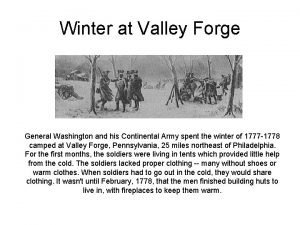Valley Forge Karmen Allison 11 27 12 3








- Slides: 8

Valley Forge Karmen Allison 11 -27 -12 3 rd

History Britain initiated policies aimed at bringing the colonists under closer control. As tensions grew many Americans stood firm in their belief that the King had suspended their natural rights. Increasingly, resistance leaders banded together. The stage for the Revolution was set. Valley Forge was a 1777 -1778 winter encampment of the Continental Army. They fought under General George Washington. The Continental Army became a disciplined fighting force. In 1777 the British strategy included a plan to capture Philadelphia, the patriot capitol. Sir William Howe landed nearly 17, 000 of His Majesty’s troops at Chesapeake Bay. General George Washington took his 12, 000 -man army from New Jersey. People often thought of the Continental Army as a ragtag group of inexperienced fighters. Washington’s men fought skillfully. They may have lost two important battles, but they emerged from these losses with great confidence in their abilities to fight. It only took just a little more training to reach their full potential.

History continued…. . As the cold weather approached, armies often retreated to fixed camps. Shortages on clothes caused terrible hardship to the men. When they reached camps they didn’t hear howling winds, they heard hammers, axes, saws, and shovels at work. Death tolls were limited due to dedicated surgeons, capable nurses, a smallpox inoculation program, and camp sanitation regulations. The most important outcome of the encampment was ho much the army matured into a professional force.

History continued…. . Augustus Von Steubon’s training program helped the army become a better marching machine. On May 6, 1778, the army celebrated France’s alliance with the United States. The arrival of the French altered British war plans and caused the evacuation of Philadelphia in June.

History continued…. Washington rapidly set troops to bring on a meeting with the enemy. By summer Washington claimed that the war was going well. In order to stabilize the army, Congress let General George Washington recruit men for three years. In return for such service Congress offered land financial bonuses. The troops came from all thirteen original states and regiments from all except South Carolina and Georgia. Encampments brought men, women, and children of all ages and religions together. There were African, American Indian, Portuguese, Austrian, German, Polish, Dutch, French, Irish, Scottish, Italian, Swedish, Spanish, and English. Women went with the army to be with their husbands. The women who followed consisted of troop’s wives who were with them year round and general officers who were on extended visits.

History continued…. Women were paid for helping with laundry, nursing, and sewing.

History continued…. Enslaved African Americans were motivated to join British and Continental forces due to promises of freedom. In the Continental Army, bound men wanting to be free serve along with freemen in hopes of having a better life. The Continental regiments include African American Indians sided with the British to preserve culture and prevent the taking of their land. Some tribes supported the Patriots due to political, religious, and personal ties. Hundreds of Indians enrolled in the Continental Army and many others, they enrolled as specialized units. Roman Catholics and Jews supported the Patriot cause so that they could defend both religious and homeland freedom.

History continued…. The conclusion of the Revolution marked only the beginning of the struggle for some individuals for liberty. As the sound of combat grew smaller, the battle for individual rights began.














